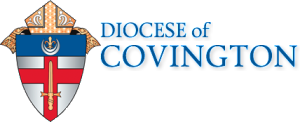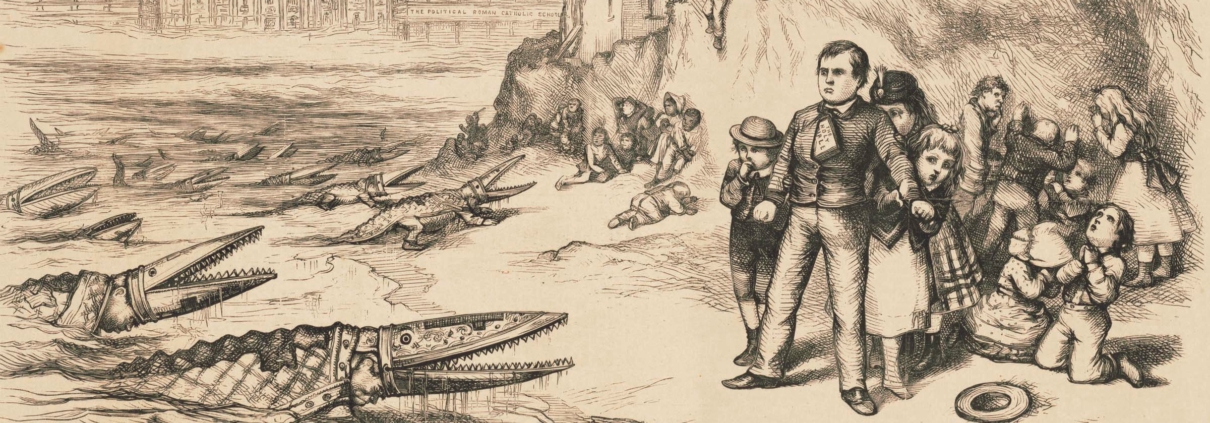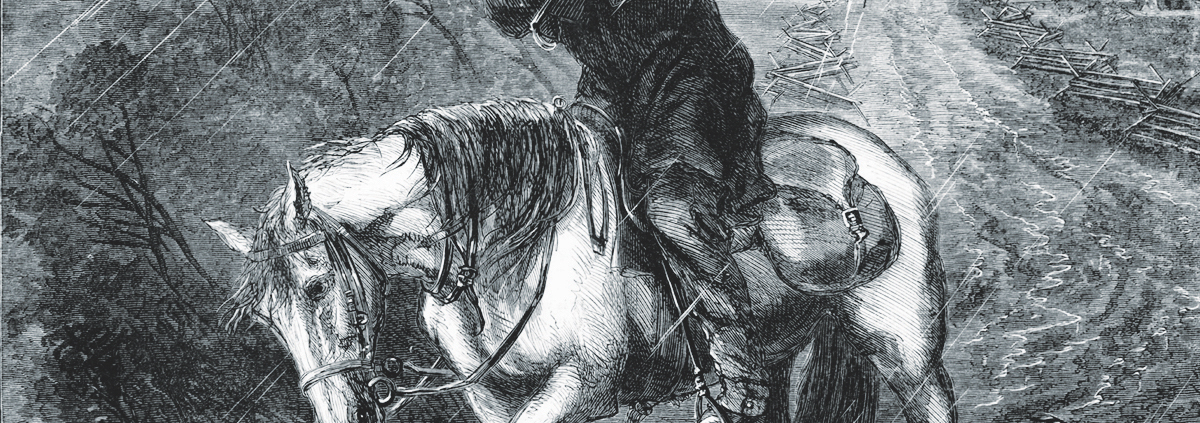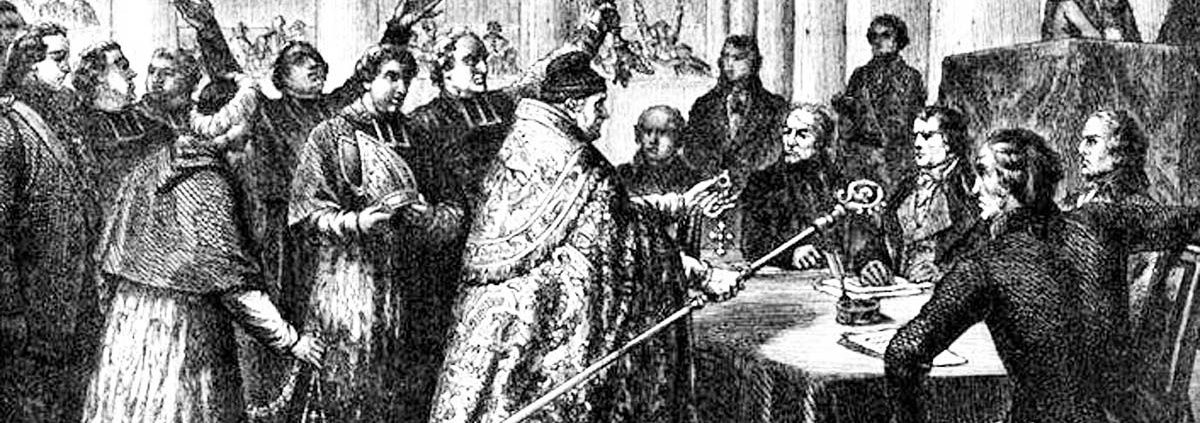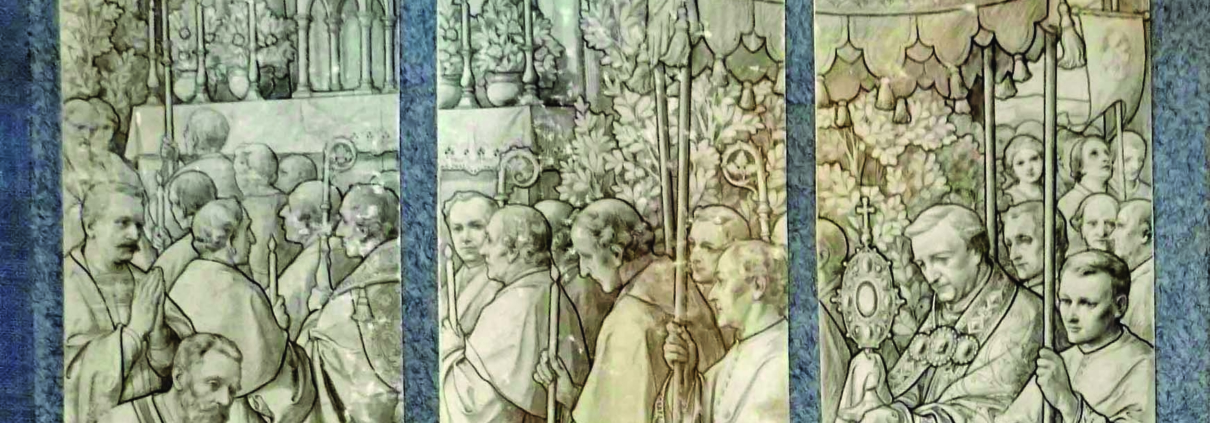Part 4: 19th century Know Nothings and anti-Catholicism
Stephen Enzweiler, Cathedral Historian
Part 4 in a series
On Aug. 6, 1855, a large mob descended upon the election polls in Louisville, Ky., and made a show of force to block Irish and German Catholics of the city from voting in the day’s election. What transpired was a day-long series of beatings, lootings, acts of arson and murder. German breweries were burned, immigrant homes and businesses were looted, Catholic churches were vandalized and the Eucharist desecrated. Loaded cannons were rolled up in front of and pointed at St. Martin’s Church, ready for firing. Of the more than 1,000 Catholics eligible to vote that day, only 20 were able to cast a ballot. As evening fell and the mobs dispersed, 22 people were dead and parts of the city lay in ashes. History would remember it as “Bloody Monday.”
Bloody Monday was just one incident among many resulting from a growing mid-19th century anti-Catholic sentiment called nativism.
Nativism was a political position derived from the policy of protecting the interests of native-born or established American inhabitants against the interests of immigrants. For 156 years before the American Revolution, the religious, cultural and political landscape had been dominated by generations of mostly English Protestants. As the flow of Catholic immigrants increased in the early 19th century, this dominance was weakened as immigrants began playing greater roles in determining the cultural identity and political direction of the country.
Anti-Catholic prejudice was first brought to colonial America by Protestant Europeans, predominantly English Pilgrims who were themselves victims of religious persecution by the Church of England. They shunned its traditions and rubrics of worship which they believed were rooted in Roman Catholicism. As a result, early American religious culture evolved with a deeply Protestant emphasis. Thus, being English meant being “anti-Catholic.” British colonies like Virginia enacted laws prohibiting Catholics from owning land, marrying, having businesses, or becoming lawyers. Maryland double taxed Catholics and enacted laws that outlawed the Mass, the Sacraments, and Catholic education.
In the first two centuries of the colonial period, there were basically two varieties of anti-Catholic prejudice. The first was of the biblical variety, a theological byproduct of the Protestant Reformation and the European wars of religion. Early American religious identity was largely either Anglican or Puritan. Clashes between the two gave birth to new movements, such as the Congregationalists, Baptists, Methodists, Quakers, Unitarians and others. But the colonial worldview did not include Catholics; it accused the pope of being the Anti-Christ and Rome of being “Babylon the great, mother of harlots and of the earth’s abominations” [Rev 17:5].
The second variety evolved in the early 19th century from a xenophobic and ethnocentric distrust of the increasing numbers of Roman Catholic immigrants coming into the country. These foreigners were said to be under the influence of Rome and under the direction of the pope who wanted to infiltrate the country and replace democracy with obedience to the papacy. This threatened the long-standing Anglo-Protestant dominance that had prevailed in America since the time of the Mayflower, and it gave rise to the use of derogatory, anti-Catholic pejoratives such as Romanism, papism, and popery.
Know Nothingism is perhaps the most infamous of the anti-Catholic movements to come out of the 19th century. Founded in 1849 as the “Order of the Star-Spangled Banner,” it viewed Catholics as foreigners under the control of the Pope in Rome. Later known as the American Party, Know Nothingism evolved into a secret political movement formed to organize native-born Protestants in opposition to the growing numbers of Catholic immigrants from Europe. They were called “Know Nothings” because members were required to answer “I know nothing” whenever asked about details of their organization. The secrecy was understandable, considering Know Nothing members were known to engage in almost every kind of violence to achieve their anti-Catholic objectives.
By 1852, the Know Nothings were achieving phenomenal national growth, largely due to the intellectual and financial contributions of none other than Samuel F. B. Morse, the inventor of the telegraph, an eminently respected American — and a rabid anti-Catholic. Morse accused the Vatican of subverting traditional Protestant values and ideals. He wrote prolifically and published pamphlets against the Catholics, charging that “Popery” is a political as well as a religious system, and he called Catholicism the “cloven foot of foreign heresy.” Morse remained vigorously anti-Catholic for the rest of his life.
In the same year the Know Nothings were formed, the first group of Franciscans came to Cincinnati. In his journal in 1844, Father William Unterthiner described the reaction of city residents who saw Franciscans walking the streets in their brown habits. “Some people threw wooden sticks at us,” he wrote, “and cursed us as we walked down the street. It is certainly true that a person is free to choose one, or even no religion, but one would still be very mistaken if he believed that Catholics are allowed to live unhindered.”
In 1853, Pope Pius IX sent Archbishop Gaetano Bedini to the U.S. to report on the state of the Catholic Church in America. During his visit to Cincinnati, hundreds of protesters marched on St. Peter’s Cathedral with a scaffold from which an effigy of the archbishop was hanging along with signs that read “Down with Bedini!,” “No Priests, No Kings,” “Down with the Butchers of Rome!” and “Down with the Papacy!” The riot that resulted became known as the Cincinnati Riot of 1853, and claimed the life of one protester, with 15 wounded, and 63 arrested. Bedini’s visit to other cities fared no better, as violent demonstrations erupted against his visit in Louisville, Cleveland, Baltimore, and Boston. In New York, the threat of violence was expected, and Bedini was secreted by rowboat to a waiting steamship in the harbor on which he immediately departed for Europe.
In the same year as the Cincinnati riot (1853), Pope Pius IX carved a new see out of the eastern Kentucky landscape and appointed a quiet academic named Father George Aloyisius Carrell as the first Bishop of Covington. The episcopate of Bishop Carrell would be a difficult one to say the least. From the very beginning, he had to endure persistent nativist aggression and the anti-Catholic threats of Know Nothings. There were outdoor rallies, threats and protest marches against the Church. In response, a number of priests printed pamphlets and periodicals in defense of the new diocese and Roman Catholicism. Editors of the “Catholic Advocate” reminded its Bardstown readership that “persecution is wisely permitted to try the fidelity of God’s servants, to purify and disengage them from this earth; and to prove that God can preserve his Church against all human opposition.”
Bishop Carrell was no doubt reminded of Jesus’ own words, “If the world hates you, understand that it hated me first” [Jn 15:18]. But the new bishop and his small band of just six priests faced the dangers with Christlike courage. “In courthouses and community halls,” penned Father Paul Ryan in his 1954 History of the Diocese of Covington, “where others who denounced that un-American activity had pistols primed for defense on the desk before them, Bishop Carrell fearlessly stood unprotected, explaining the Catholic teaching with a natural eloquence.”
It should be noted that the vast majority of anti-Catholic agitation across America was non-violent. Yet every priest, as they went about their ordinary duties, knew that danger was never very far away. Still vivid in their memory was the unhappy story of one of their own — Father Charles F. Broeswald. Father Broeswald had been a well-known figure in Northern Kentucky in the 1840’s. Assigned here by Bishop Flaget in 1844, he founded Corpus Christi Church in Newport and served as its first pastor until being reassigned to Louisville in 1846. There, he founded St. Mary Church, where he remained its pastor for the next nine years. On the night of Nov. 2, 1855, Father Boeswald was returning home from a routine sick call when he was killed by a mob of Know Nothings.
The power and influence of the Know Nothings came to an unceremonious end after the 1856 election, and by 1860 they had become largely irrelevant as an effective social and political movement. But it was the Civil War that became the principal cause of decline in 19th century anti-Catholicism. Irish and German immigrants had rushed by the tens of thousands to enlist in the fight in the nation’s struggle to put down the rebellion. Their great number of enlistments in the Union Army — and their heavy losses in battle — would go on to dispel any lingering notions about Catholics and immigrant disloyalty.
But just below the surface, the smoldering embers of anti-Catholic prejudice and discontent would continue to linger … and wait … for a new opportunity and another time to emerge.
Coming in Part 5: The Lightning that came from the East
